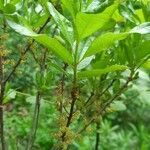Bushy shrub 0.5–2 m; lvs deciduous, broadly oblanceolate to obovate or elliptic, mostly 4–8 × 1.5–3 cm and 2.5–4 times as long as wide, obtuse or rounded and minutely apiculate, entire or with a few low teeth toward the tip, generally (as also the twigs) with some glandless white hairs, in addition to the resinous glands, at least when young, the glands sometimes of 2 sorts as in no. 4 [Myrica cerifera L.], sometimes not; terminal bud present; outer bud scales glabrous, eciliate, broadly rounded distally; staminate catkins produced below the leafy branches in May or June, cylindric, 6–15 mm, with broadly quadrate bracts; anthers formed in the spring; pistillate catkins slender, 5–10 mm, with ovate bracts; bracteoles 4–6, ± persistent but remaining small and inconspicuous; ovary densely hairy as well as papillate; frs solitary or few in a cluster, subglobose, 3.5–5 mm, covered with a thick layer of white wax that masks the underlying papillae, and also ± densely short-hairy; 2n=16. Dry hills and shores, especially near the coast, from Nf. to N.C., and less commonly inland to O. and s. Ont. (Morella p.; Myrica and Cerothamnus caroliniensis of authors, perhaps not of Mill.)
A shrub. It grows 1.8-3 m high. It is spreading and suckering. It loses many or all of its leaves depending on how cold the climate is. The leaves are 2.5-8 cm long and sword shaped. The leaves may or may not have teeth around the edge. The fruit are waxy berries. They are pale grey.



